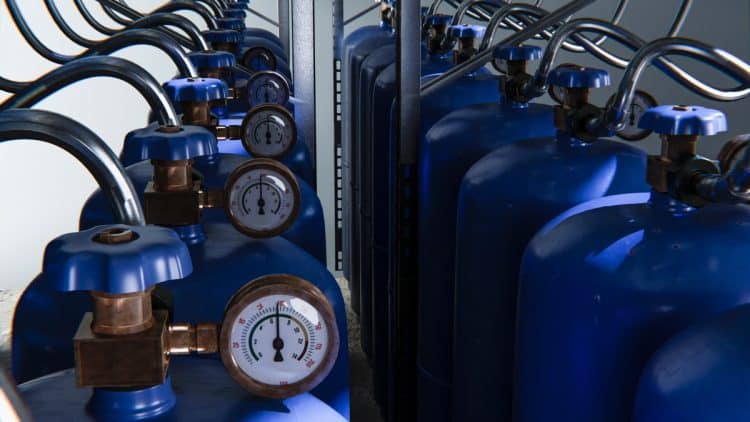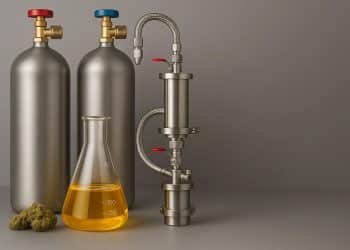Supercritical fluid extraction (SFE) is an effective method to separate valuable compounds from plant matrices, with high efficiency and selectivity.
Supercritical fluids are highly compressed gasses which at a certain specific temperature and pressure behave half way between a gas and a liquid. Once reached the supercritical state, the extraction solvent density increases with the increase of the pressure, in turn enhancing the solubility of the extracted materials. [1]
SFE has been developed as a green alternative to other conventional extraction methods which usually involve large amounts of solvents and produce large volumes of wastes.
Moreover through SFE it is possible to conduct a selective extraction by accurately tuning pressure and temperature and preserving the volatiles of the extract and all the thermolabile molecules which can be damaged during conventional extraction processes. [2]
The process of SFE extraction can be divided into two steps:
- The plant material is solubilized with the solvent at the supercritical state;
- The extracted compounds are then recovered from the solvent to produce the end product.
Supercritical CO2
Carbon dioxide (CO2) is the most widely used solvent for SFE. This is because CO2 can relatively easily reach its critical temperature (31°C) and critical pressure (74 bar). Sometimes small amounts of a co-solvent such as methanol, ethanol or water can be added in order to increase the polarity of supercritical CO2 and to enhance the solubility of certain polar compounds.
SFE doesn’t leave behind solvent residues in the final extract. In fact at atmospheric pressure CO2 is a gas so all the solvent will evaporate leaving a purer final extract compared to other extraction methods.
In addition to that CO2 is non-toxic, odorless, tasteless, non-flammable and relatively cheap. SFE using CO2 as solvent is considered a green extraction method because the solvent can be reused: performing the extraction in a closed-loop system allows the recycling of the solvent that can be then stored in a tank till the next use.
Even if CO2 is a greenhouse gas, the extraction process removes it from the environment and once it is expelled back it doesn’t result in an increase of the greenhouse emissions. Due to its relatively low critical temperature and good safety profile, CO2 is largely used in food, essential oils, aromas and nutraceutical industries. [2]
Benefits of SFE Compared to Conventional Methods
- Control the extraction parameters such as temperature and pressure with direct impact on the solvent density, thus the extractants solubility;
- Improved selectivity of the target compound;
- Improved mass-transfer properties;
- Higher extraction yields;
- Shorter extraction time;
- Lower solvent residues in the final extract.
Cannabis and Supercritical CO2 Extraction
Cannabis plants can be successfully extracted with SFE technique using supercritical CO2 (scCO2) as solvent. In this particular state, CO2 is slightly non-polar. This feature is essential in order to efficiently extract cannabinoids, the main active phytoconstituents of cannabis.
Among cannabinoids the most well-known and desired are tetrahydrocannabinol (THC) and cannabidiol (CBD). The former is psychotropic, but has many potential therapeutic effects including analgesic, anti-anxiety, antiemetic among others. The latter, unlike THC, doesn’t alter perceptions and is a potential anti-inflammatory, neuroprotective, analgesic, anti-anxiety agent among other beneficial effects.
Cannabis plant material can be extracted while maintaining the integrity and the concentration of terpenes found in that specific sample. The whole process can be performed with the same solvent, on the same plant matter to selectively extract different components at different stages.
The extraction yield of phytoconstituents is highly dependent on the pressure used during the process and the plant material starting composition. In some cases it is possible to add a co-solvent like ethanol to improve the extraction range.
SFE using CO2 as solvent is well-known for its ability to create a wide variety of products and full-spectrum extracts. Flavor, aromas and composition of a particular cannabis strain can be obtained efficiently using this technique. The common CO2 cannabis-derivatives produce: concentrates, edibles, topicals, vapes and tinctures.
How to Perform scCO2 Extraction?
- The operator can dry the extracted plant sample in order to reduce the amount of contained water that could lead to a reduced yield. Other procedures involve the freezing of the plant material to remove the moisture and to ease the disruption of cell walls thus the extraction of the active plant constituents. The plant material can be ground in order to increase the exposed surface to the solvent;
- Then he seals the extraction vessel and sets the pressure and temperature parameters. The liquefied CO2 at the supercritical state enters the extraction vessel and flows through the plant material extracting the phytocomponents;
- The extract enters the separation chamber. Here the CO2 returns to its gas state releasing the pressure and goes back to the extraction chamber in order to continue extracting all the molecules of interest. On the other hand the extracted substances drop out the gas stream and they are collected in a separate cup.
The selection of the right parameters when performing a scCO2 extraction is crucial in order to maximize the quality and the quantity of the final extract, reducing the post-processing procedures and obtaining an extract with the same composition found in the plant matter.
Extraction Equipment for Supercritical CO2 Extraction
This extraction technique is performed in a closed-loop system, where the solvent is stored in a sealed container and it can be recycled for other extraction runs. Depending on the scale of the operation, the budget for the project business, the types of desired final products and the size of the facility, various type of extraction equipment can be used.
The main variables to take into account for this type of extraction are:
- The high pressure of the system transforms the state of the solvent;
- The efficient heat delivery to change the solvent and extract temperature;
- The possibility of knowing the solvent temperature in order to finely tune the solvent density.
It is recommended to invest in a flow monitoring system and a solvent pump to check the entrance and rate of the solvent into the extraction vessel. Moreover the separation chamber can be adjusted in order to separate different components depending on the applied pressure, to create a variety of cannabis-derived products.
Disadvantages of Supercritical CO2 Extraction
The solvent requires a relatively high pressure in order to reach the supercritical state. This implies the fact that the machinery used to perform the extraction has to be built in order to sustain high pressure making it quite expensive.
The relatively high operating pressure results sometimes in the extraction of unwanted substances like fats, lipids and waxes. Often a further purification step is required in order to obtain a final product without unwanted residues.
References:
- Pimentel-Moral, Sandra; Borrás-Linares, Isabel; Lozano-Sánchez, Jesús; Arráez-Román, David; Martínez-Férez, Antonio; Segura-Carretero, Antonio (2018). Supercritical CO2 extraction of bioactive compounds from Hibiscus sabdariffa. The Journal of Supercritical Fluids, (), S0896844618305321–.doi:10.1016/j.supflu.2018.11.005
- https://www.tsijournals.com/articles/supercritical-fluid-extraction–a-review.pdf












